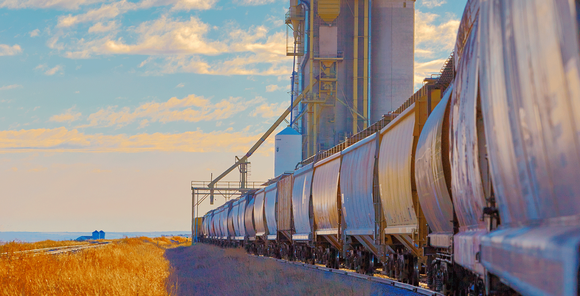CSX Looks for a Railroad Renaissance
The railroad industry has gone through a lot in recent years, as turbulent conditions in many of the end markets that key railroad customers serve have led to volatile levels of volume and revenue. CSX (NASDAQ: CSX) has also had to deal with an unexpected CEO transition in the middle of turnaround efforts that the railroad company had hoped would be able to pull it out of a long funk.
Coming into Wednesday's first-quarter financial report, CSX investors expected to see some reductions in its top line but hoped for stronger profits. The railroad's results were better than most had expected, and with solid gains in key metrics, many are optimistic that CSX could be in the beginning stages of what could become a renaissance in the railroad industry.

Image source: CSX.
CSX hits the gas
CSX's first-quarter results weren't the strongest ever, but they were still satisfying to see. Revenue inched higher by just a fraction of a percentage point to $2.88 billion, which was better than the drop of more than 2% that most CSX investors had expected to see. Net income nearly doubled to $695 million, and earnings of $0.78 per share were well above the consensus forecast among those following the stock for $0.66 per share.
Most of CSX's success came from the company's efforts to rein in costs. Expenses were down 13% from year-ago levels, as restructuring charges in past periods have led to substantial savings in areas like labor and materials and supplies. Even a rise in fuel costs didn't do much to eat into CSX's cost-cutting measures. Lower tax rates also helped, as CSX paid less in income tax this year despite having pre-tax earnings that were more than 50% higher than year-earlier numbers.
Still, CSX faces some ongoing challenges from a fundamental perspective. Volume fell 4%, with the biggest declines coming from fertilizers and agricultural and food products. Shipments of metals and equipment and chemicals were also pretty weak, and even the best-performing areas of forest products and intermodal transport could only produce flat volume compared to the year-earlier period. Coal volume fell just 2%, but it was also the only area in which revenue per unit also declined. Overall, a 4% rise in revenue per unit shipped was the saving grace for overall sales.
Operational metrics were mixed. Train velocity and delay times improved from the first quarter of 2017, and on-time arrivals rose to 57%. Yet personal injury frequency and train accident rates were higher by double-digit percentages, challenging CSX's safety record.
What's next for CSX?
CEO James Foote put the railroad's efforts in context. "Since implementation of scheduled railroading began in March 2017," Foote said, "CSX has taken significant strides to transform the organization and to make CSX more competitive." The CEO pointed to new opportunities to grow the railroad's business, both by offering competitive advantages compared to its closest rivals and by attracting new attention to railroads as a transportation option.
CSX is still fairly optimistic about its prospects for the coming year. Foote still expects full-year sales to rise slightly, and the railroad is committed to keep improving its service performance while seeking out new ways to make itself significantly more efficient. Safety also remains CSX's top priority. If those favorable business trends continue, then further declines in operating ratios could spell higher profits for the full year. Already, CSX has shared a sizable portion of its capital with shareholders by buying back stock, spending $836 million on buybacks during the quarter compared to just $258 million in the year-ago period.
Investors in CSX seemed quite pleased with the report, and the stock jumped more than 6% on Thursday following the Wednesday evening announcement. If the railroad can keep moving forward with innovative new ideas to bolster its business, then CSX could truly bring about a new renaissance for the railroad industry that could drive returns for years to come.
More From The Motley Fool
Dan Caplinger has no position in any of the stocks mentioned. The Motley Fool has no position in any of the stocks mentioned. The Motley Fool has a disclosure policy.

 Yahoo Finance
Yahoo Finance 